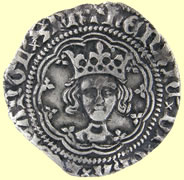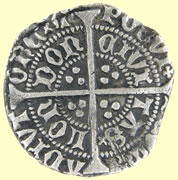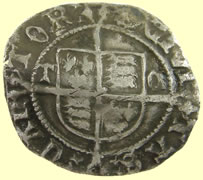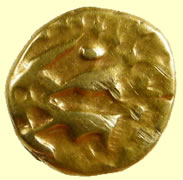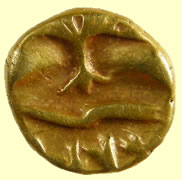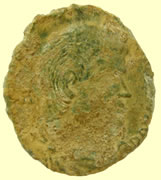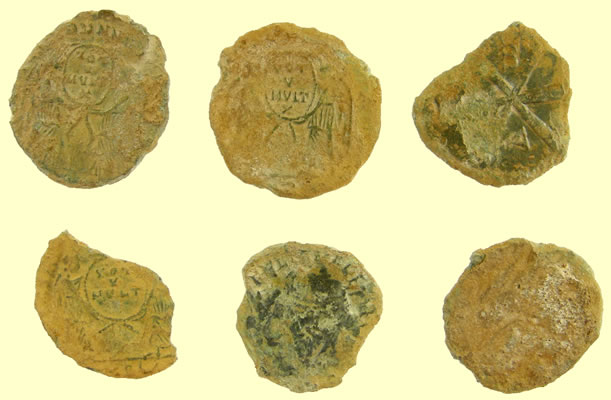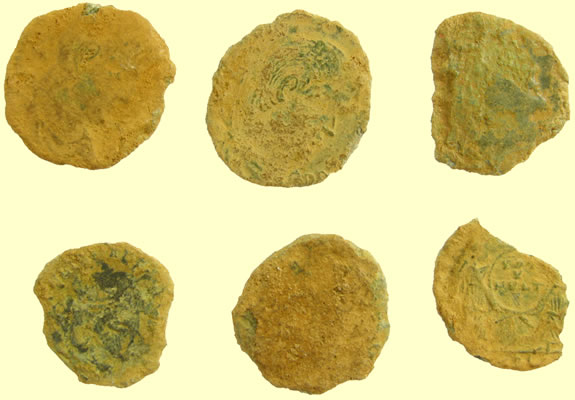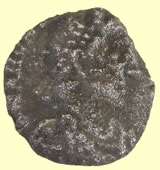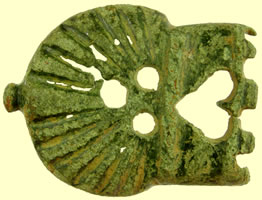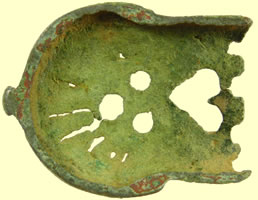

Metal detecting holidays in England with the World's most successful metal detecting club.
Twinned with Midwest Historical Research Society USA
Sept 2019 finds page |
|||||||||||||
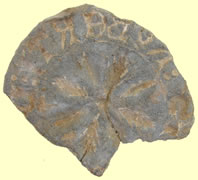 |
 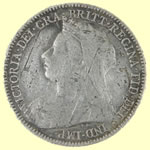 |
||||||||||||
|
1260 AD Non Heraldic personal seal of freeholders, 4 have been found attached to pasture rights. The design is typical of mid 13thC non heraldic seals and part legend reads : AVDERTI:D
|
1894 Victorian milled silver sixpence |
||||||||||||
  |
 |
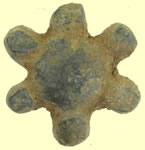 |
 |
||||||||||
17th hooked fastener |
17thC decorated sword hanger | Roman military baldric mount |
Georgian harness decoration |
||||||||||
1464 -1476 Edward IV - (Archiepiscopal issue) Archbishop George Neville hammered silver half penny 14.35mm , 0.55g Quatrefoil with pellet at centre of reverse cross - - G and key by bust York mint |
1341 Edward III hammered silver Florin penny Obv - EDWAR ANGL DNS HYB Rev CIVI/TAS/LON/DON - London mint 18.88mm, 1.35g |
||||||||||||
1645 Charles 1st hammered silver shilling (12 pence) Tower mint under parliamant - Sun mint mark |
|||||||||||||
1217/8 Henry III hamered silver short cross silver penny Class 7a Obv HENRICVS REX Rev RE(INAVD on C(A - Moneyer Reinald of Canterbury mint 19.98mm, 1.34g |
1204/5 King John hammered silver cut halfpenny Class 5a - E before sceptre Obv **** ald on *** 0.54g, 17.8mm |
||||||||||||
(1576-1612) Rudolf II. Dutch city Zwole 29.3mm, 4.01g |
Looks like a Henry V penny - not checked the books yet |
||||||||||||
1601-2 Elizabeth 1st hammered silver half groat 17.10mm, 0.88g - 7th issue, '1' mintmark |
17thC mount |
||||||||||||
C10thC Saxon stirrup mount - Class B type 2 - Mounts with central heads and flanking beasts 46.71mm L x32.99mm W x 4.09mm T |
|||||||||||||
 |
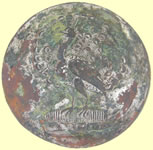 |
 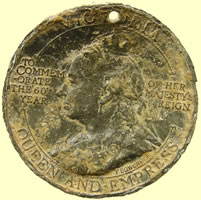 |
|||||||||||
Georgian watch winder |
19thC livery button |
Queen Victoria 60th year medallion |
|||||||||||
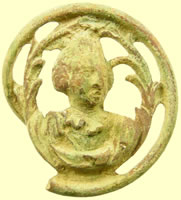 |
 |
||||||||||||
Large Georgian mount |
Royal artillery cap badge |
||||||||||||
 |
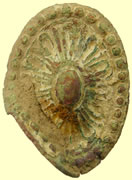 |
 |
|||||||||||
Large piece of medieval bonze pot bowl with rim |
Georgian mount |
17thC lead token |
|||||||||||
 |
 |
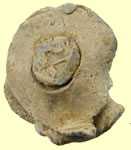 |
|||||||||||
Lead sewing palm guard |
15thC lead token - flower petal type |
Post medieval cloth seal |
|||||||||||
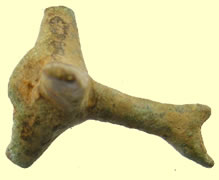 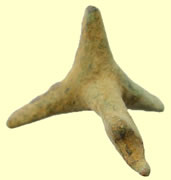 |
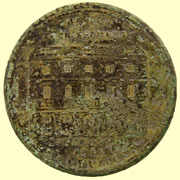  |
||||||||||||
Roman prick spur |
1820 The old stock exchange - Auctioners, Sales of Estate houses token |
||||||||||||
  |
|||||||||||||
1804 George III milled silver dollar (5 shillings) forgery |
|||||||||||||
 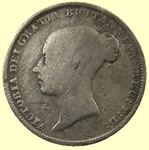 |
 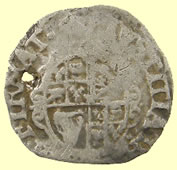 |
||||||||||||
1850 Victorian milled silver sixpence |
1625 Charles 1st hammered silver half groat |
||||||||||||
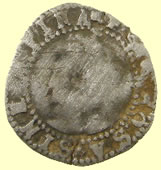 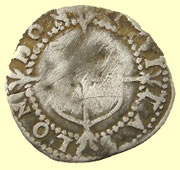 |
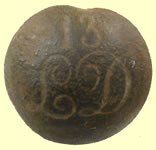 |
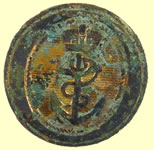 |
|||||||||||
1594-6 Elizabeth 1st hammered silver half groat |
'Still unrecorded, but I have it in my book as the below' 13th Light Dragoons |
RN Capt / Commander - 1812 |
|||||||||||
  |
 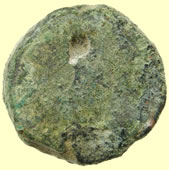 |
||||||||||||
1760's £3 12 shilling coin weight - used to weigh the Portuguese moidore series of gold coins 28.11mm, 27.96g The name moidore is derived from Portuguese moeda de ouro, which literally meant "golden coin". |
AD 1293 – 22 August 1350
Lamb left standing with banner coin wieight- French made weight for two coins , the agnel d'or of Philip VI, or the d'or of Jean le Bon and Charles VI legend: P DE LAENEL Maker HENRIC LE LOMBART 23.58g, 22.10mm |
||||||||||||
 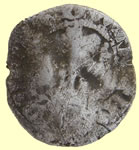 |
  |
||||||||||||
1341 Edward III hammered silver florin penny Obv - EDWAR ANGL DNS HYB Rev CIVI/TAS/****EME - Durham mint |
1341 Edward III hammered silver florin penny **** ANGL DNS HYB Obv CIVI/TAS/CAN/TOR -Canterbury mint |
||||||||||||
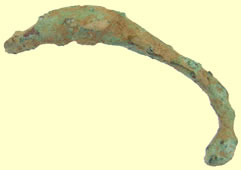 |
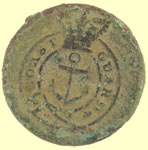 |
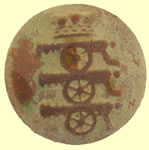 |
|||||||||||
Roman Delous buckle |
HM coast guard button |
Royal Artillery button Dates - 1840 - 1855 |
|||||||||||
 |
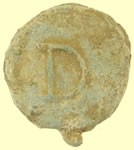 |
 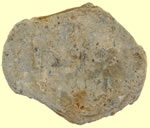 |
|||||||||||
Royal Artillery button Dates - 1840 - 1855 |
17thC lead token |
Post medieval lead bale seal |
|||||||||||
 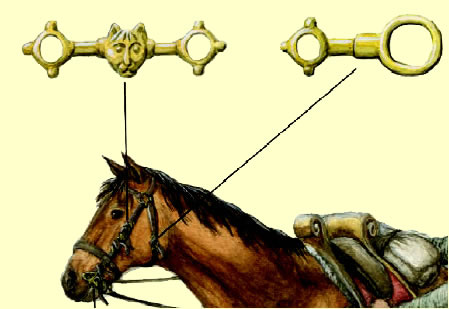 |
|||||||||||||
2 - Incomplete
harness strap distributors (probably a bridle cheek piece) of the late
Anglo-Saxon period |
|||||||||||||
 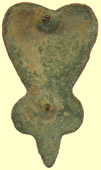 |
 |
||||||||||||
17thC mount with 2 integral lugs |
18thC decorated clog fastener |
||||||||||||
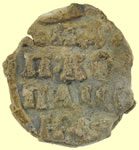 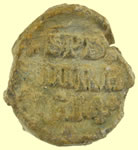 |
 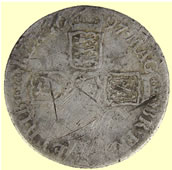 |
||||||||||||
1814 Russian lead bale seal - St Petersburg |
1697 William III milled silver shilling |
||||||||||||
PORTUGAL.John II 1481-1495.AR.Real (Vintem).Lisbon mint. 18.64mm,1.98g
|
|||||||||||||
Very rare 1272 Edward 1st hammered silver penny - Class 1a - Lombardic N Obv EDW REX ANGL DNS HYB Rev CIVI/TAS/LON/DON - London mint 1.24g, 17.30mm |
|||||||||||||
 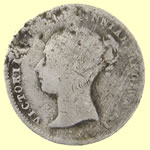 |
 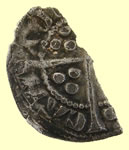 |
||||||||||||
1848 Victorian milled silver 4 pence |
1341 Edward III hammered silver florin penny
Obv ***** ANGL DNS HYB Rev CIVI/TAS/CAN/TOR - Canterbury mint |
||||||||||||
 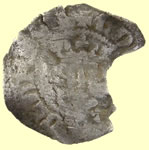 |
 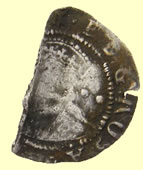 |
||||||||||||
1341 Edward III hammered silver florin penny Obv ED ***** ANGL DNS HYB Rev aDV/NOL/MIE Durham mint 20mm |
1582 - 4 Elizabeth 1st hammered silver half groat - A mint mark |
||||||||||||
 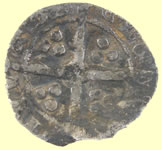 |
 |
 |
|||||||||||
1327-1335 Edward III hammered silver penny - First coinage - Archiepiscopal issue -Reverse has quatrefoil with pellet at centre Obv EDWARDVS REX A *** Rev CIVI/TAS/EBO/RACI - York mint 17.27mm, 0.85g |
Medieval hammered silver penny in poor shape |
Medieval hammered silver penny in poor shape |
|||||||||||
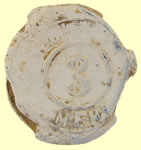 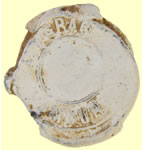 |
 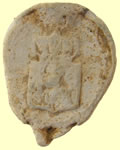 |
||||||||||||
Post medieval lead bale seal |
1678 Dutch lead bale seal |
||||||||||||
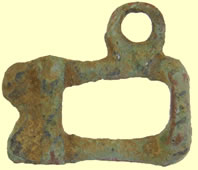 |
 |
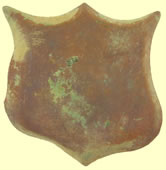 |
|||||||||||
17thC sword belt fitting |
Medieval mount - rivet fixing |
18thC shield mount |
|||||||||||
|
|
||||||||||||
Large 17thC mount with 4 integral lugs |
Saxon period helmet trim, classic punched circle pattern. |
||||||||||||
|
  |
||||||||||||
17thC decorated belt slide - fern design |
17thC acorn mount with 2 integral lugs |
||||||||||||
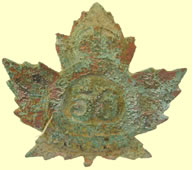 |
 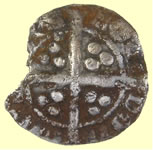 |
||||||||||||
56th Regiment of foot badge |
1341 Edward III hammered silver florin penny Obv EDWR ANGL ****** Rev CIVI/TAS/LON/DON - London mint |
||||||||||||
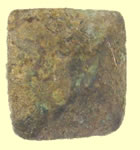 |
 |
 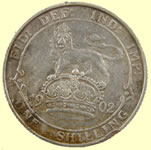 |
|||||||||||
Medieval prism mount |
Roman dolphin headed open looped buckle fragment |
1902 Edward VII milled silver shilling |
|||||||||||
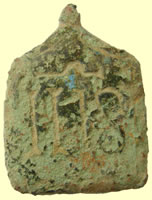 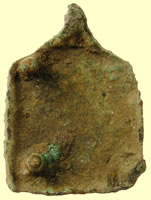 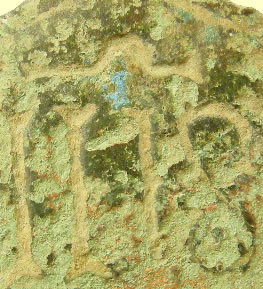 |
|||||||||||||
Medieval enameled religious belt end- IHS, initials for IESUS HRISTOS SALVATOR, Jesus savior of man - some red and blue enameling remains Nail of christ's cross above the lettering In the Latin-speaking Christianity of medieval Western Europe, the most common Christogram is "IHS" or "IHC", derived from the first three letters of the Greek name of Jesus, iota-eta-sigma. Here, the Greek letter eta was transliterated as the letter H in the Latin-speaking west (Greek eta and Latin-alphabet H had the same visual appearance and shared a common historical origin), while the Greek letter sigma was either transliterated as the Latin letter C (due to the visually similar form of the lunate sigma), or as Latin S (since these letters of the two alphabets wrote the same sound). Because the Latin-alphabet letters I and J were not systematically distinguished until the 17th century, "JHS" and "JHC" are equivalent to "IHS" and "IHC". |
|||||||||||||
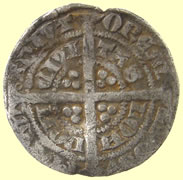 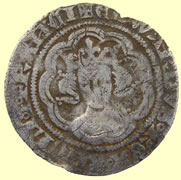 |
|||||||||||||
1351- 1352 Edward III hammered silver half groat - 4th coinage series C - pre treaty period Obv EDWAR.DVS.REX.ANGL.(I)FRAN.(NCI) + Rev CIVI/TAS/LON/DON - London mint 22.2mm,2.07g
|
|||||||||||||
  |
 |
||||||||||||
Medieval harness shield pendant |
West Yorkshire regiment lapel badge |
||||||||||||
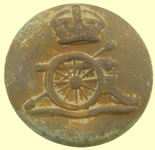 |
 |
 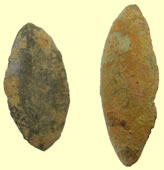 |
|||||||||||
WWII Royal artillery button |
Georgian candle holder handle |
17thC oval mounts with single integral lug |
|||||||||||
 |
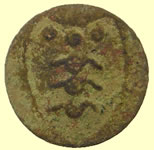 |
 |
|||||||||||
2 Georgian watch winders |
18thC Royal artillery button |
1550-1650 buckle |
|||||||||||
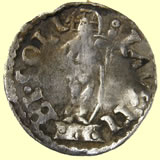 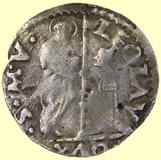 |
|
||||||||||||
Venetian Soldino hammered silver coin Rev: LAVS TIBI SOLI (Thee Alone be Praised). Haloed figure of Christ holding a cross. Obv: LEO LAV DVX S M V (Leonardo Lauredan, Doge. St Mark of Venice.) Doge kneeling before Saint Mark. Sent off to the Italian forum guys for confirmation of ID
|
Excellent 14th/15thC lead token - shield and pellet type |
||||||||||||
  |
  |
||||||||||||
1204/5 King John hammered silver half penny - Class 5b Obv HENRICVS REX Rev ****FRE(I. ON - Moneyer Gifrei of Norwich |
1247 Henry III voided long cross hammered silver half penny |
||||||||||||
 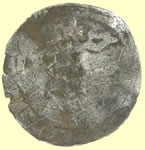 |
 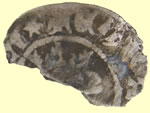 |
||||||||||||
Medieval hammered silver penny CIVI/TAS /`***** |
Very unusual Edward hammered silver penny - There is a mullet(star) stop next to the inital cross which is not one I know off - still researching Obv *+ EDWA **** Rev - CIVI/TAS/ ***** |
||||||||||||
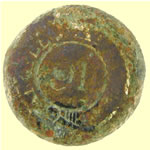 |
 |
 |
|||||||||||
Unrecorded 91st Regiment of foot button - Argyllshire Highlanders |
Medieval hammered silver fragment | Medieval strap fitting |
|||||||||||
 |
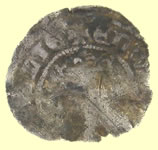 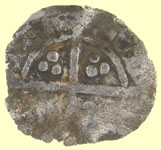 |
||||||||||||
Medieval strap fitting |
1461 Edward IV Irish hammered silver penny Obv EDW ***** NIE Rev CIVI/TAS/LON/DON - London mint |
||||||||||||
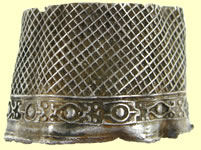 |
|
||||||||||||
18thC silver thimble |
Roman riveted plate |
||||||||||||
 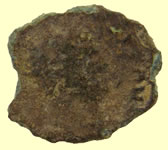 |
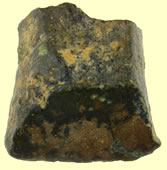 |
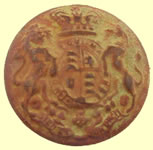 |
|||||||||||
4thC Roman bronze coin |
Medieval pot foot |
1890 pattern General service Army button |
|||||||||||
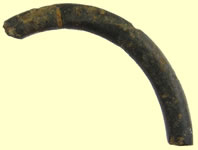 |
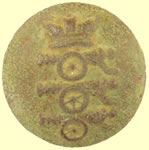 |
 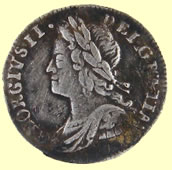 |
|||||||||||
Medieval annular buckle fragment |
Royal Artillery button Dates - 1840 - 1855 |
Tiny 1732 George II milled silver penny |
|||||||||||
Very important find as no examples exist with a clear initial mark and this appears to be a crown. The legend is also not one in the Withers reference book so I will send it off to the expert at the British museum. It is definetly a Henry VII as it has the distinctive cross fourchee cross ends only found in that King's coinage. 1485 Henry VII hammered silver half penny - 'brush' hair bust , Reverse cross fourchee , 0.26g,11.89mm Obv **** A*ORZ (Crown) Rev CIVI/TAS/ *** |
|||||||||||||
 |
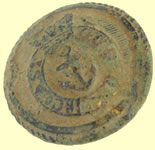 |
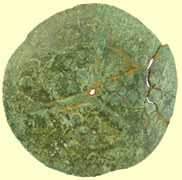 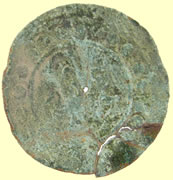 |
|||||||||||
George II trade weight - London hallmarks |
Navy button H.M. Coast Guard |
Sterling bust English Jetton 1302-50 Rev - Three armed cross, 6 pellet clusters in angles, border pellets Obv - Bust of Edward 1st trifoliate type in double circle |
|||||||||||
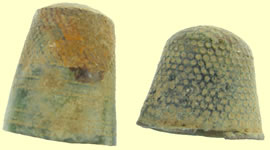 |
 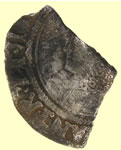 |
||||||||||||
18th & 17thC thimbles |
16thC Elizabeth 1st hammered silver sixpence |
||||||||||||
  |
 |
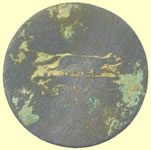 |
|||||||||||
Georgian plain silver ring |
19thC livery button |
19thC hunting button |
|||||||||||
 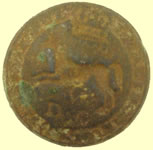 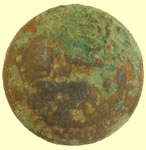  |
|||||||||||||
Unrecorded 5th Dragoon guards buttons - Crimea wars period |
|||||||||||||
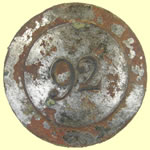 |
|
||||||||||||
|
Medieval buckle with chape 34.73mm L |
||||||||||||
C14thC Medieval gold ring 1.31g,20.40mm dia |
|||||||||||||
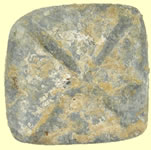 |
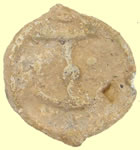 |
   |
|||||||||||
Medieval lead gaming piece |
17thC lead token - Anchor type |
Interesting brooch ? , fittings on back for pin and clasp but has a loop for a hanging pendant ? Not in the reference books so one for the museum. Feels more 17thC than Roman |
|||||||||||
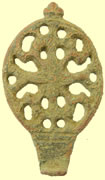 |
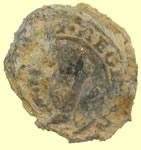 |
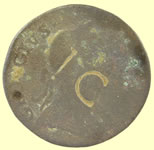 |
|||||||||||
17thC fretwork hooked fastener |
Early Irish regimental pewter button - harp design |
15thC lead token |
George 1st copper halpenny love token - overstamped IC |
||||||||||
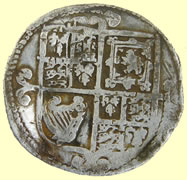  |
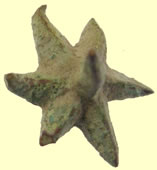 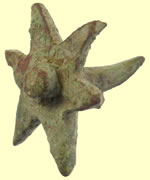 |
||||||||||||
C 1638 Charles 1st hammered silver sixpence - defaced bust during English silver war and heavily clipped - square topped shield with plume type |
Medieval prick spur |
||||||||||||
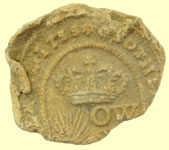 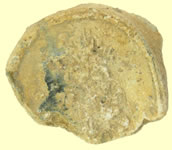 |
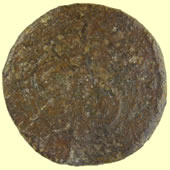 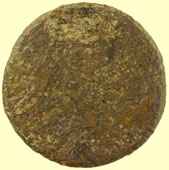 |
||||||||||||
Post Medieval lead bale seal |
17thC copper jetton |
||||||||||||
 |
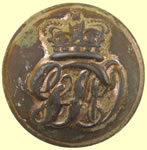 |
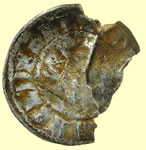 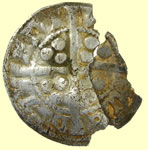 |
|||||||||||
19thC livery button |
General Post Office button |
1341 Edward III hammered silver florin penny Obv Ed****ANGL DNS HYB Rev VIL/SCIE/DMV/NDI -Bury St Edmonds mint |
|||||||||||
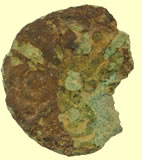 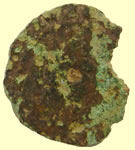 |
 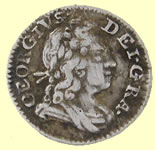 |
||||||||||||
1302- 50 AD Sterling bust English medieval jetton Obv Bust , wearing cap ,in circle:border, strokes and pellets Rev Straight cross 'quatrefoil-in-circles' in angles, border pellets |
1720 George 1st milled silver penny |
||||||||||||
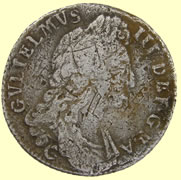  |
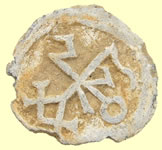  |
||||||||||||
1697 William III milled silver shilling (12 pence) Coventry mint |
Post medieval bale seal |
||||||||||||
 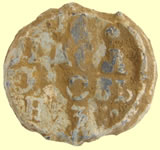 |
 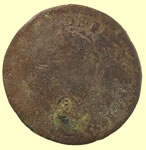 |
||||||||||||
1793 Russian lead bale seal - St Petersburg Port |
1653 Louis XIV, Liard de France 'B' type copper coin |
||||||||||||
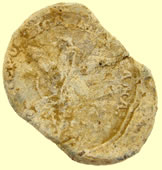 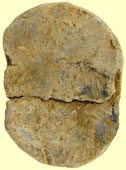 |
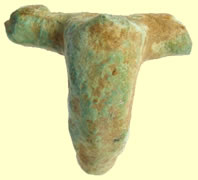 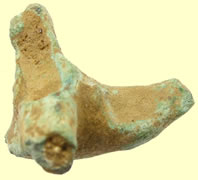 |
||||||||||||
Post medieval bale seal |
2ndC Roman fibula brooch |
||||||||||||
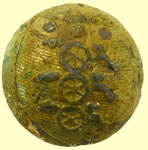 |
 |
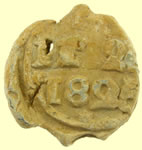 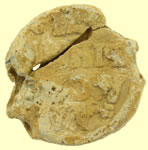 |
|||||||||||
Royal Artillery button |
Georgian gold plated watch winder | 1825 Russian lead bale seal - St Petersburg Port |
|||||||||||
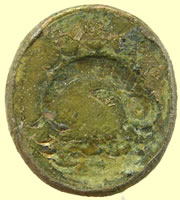  |
|||||||||||||
Really nice 17thC seal matrix - fish jumping out of water impression |
|||||||||||||
 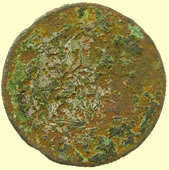 |
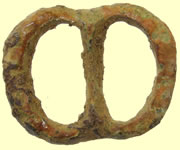 |
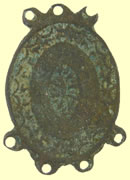 |
|||||||||||
1817 George III milled silver shilling forgery |
1550-1650 buckle |
16thC rosery hanger |
|||||||||||
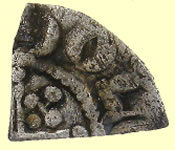  |
  |
||||||||||||
1247 Henry III short cross hammered silver farthing (cut qtr) |
1341 Edward III hammered silver florin penny - Durham mint |
||||||||||||
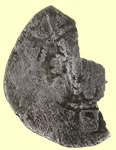 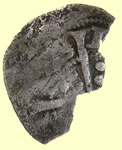 |
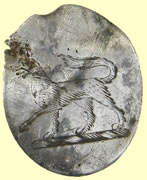 |
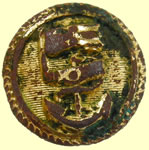 |
|||||||||||
1351-61 Edward III hammered silver pre treaty penny Obv EDWARDVS REX ANG Rev **S/L - London mint |
18thC silver cufflink |
||||||||||||
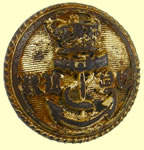 |
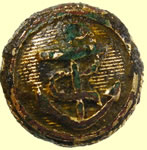 |
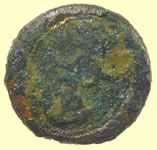 |
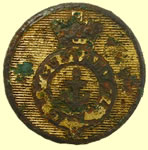 |
||||||||||
UNITED KINGDOM
Royal London Yacht Club R. T. Y. C. - R. T. Y. C. London, England In use 1837 - 1901 |
Britain's Merchant Navy BM - Extra high quality |
RN Capt / Commander - 1812 |
RN customs O/R's Button In use 1820 - 1836 ? button |
||||||||||
 |
 |
 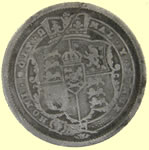 |
|||||||||||
19thC livery button |
|
1819 George III milled silver sixpence |
|||||||||||
  |
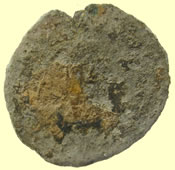 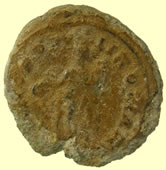 |
||||||||||||
Medieval Edward hammered silver penny Obv **** ANGL DNS **** CIVI/TAS/EBO/RACI - York mint |
4thC Roman bronze coin |
||||||||||||
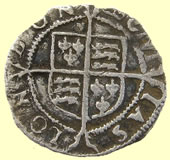  |
|
||||||||||||
1567-70 Elizabeth 1st hammered silver half groat - 4th Issue coronet mintmark |
Roman votive figurine 48.34mm L, 14.68g |
||||||||||||
Medieval badges Ref Mitchiner p244 939 - 941
|
|||||||||||||
  |
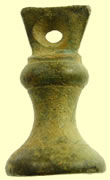  |
||||||||||||
Lead owl figurine mount - very difficult to date - one for the museum to look at |
19thC Victoria hall marked 1/2 oz bell type trade weight VA522 |
||||||||||||
 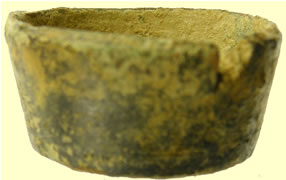 |
|||||||||||||
Very unusual bullion cup weight |
|||||||||||||
 |
 |
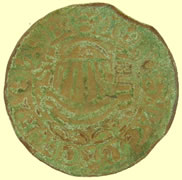  |
|||||||||||
19thC button |
15thC casket key |
1553 Hans Schultes I 'Ship penny' jetton Obv Sailing ship facing left Rev Traditional 'four fleurs in a lozenge' crown HANS rosette SCHVLTES cross PO
|
|||||||||||
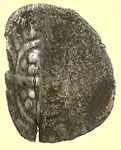 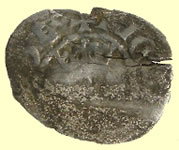 |
 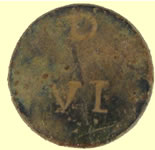 |
||||||||||||
1377-1399 Richard II hammered silver half penny Obv RICHARDxREX:ANGx Rev CIVI/TAS/LON/DON - London mint 0.48g, 13.62mm |
1680-96 6 pence silver bullion weight |
||||||||||||
|
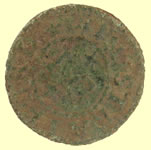  |
||||||||||||
Medieval decorated book clasp |
1653 hammered copper trade farthing - John Chandler in Stratford St Mary Suffolk |
||||||||||||
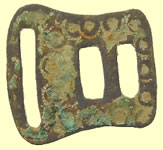 |
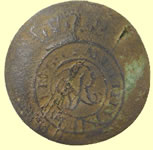 |
 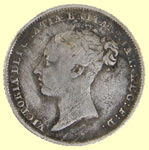 |
|||||||||||
18thC decorated clog fastener |
|
1840 Victorian milled silver sixpence |
|||||||||||
 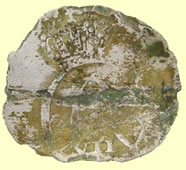 |
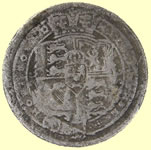 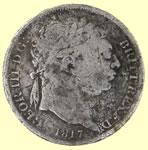 |
||||||||||||
1801 Danish 2 skilling silver coin |
1817 George III milled silver sixpence |
||||||||||||
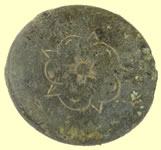 |
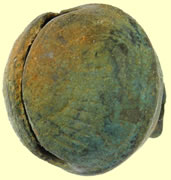 |
 |
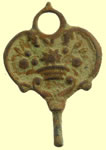 |
||||||||||
| Royal Navy Lieutenant button - 1748 |
17thC decorated crotal bell |
19thC livery button |
Georgian watch winder |
||||||||||
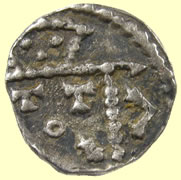 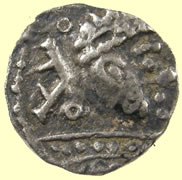 |
|||||||||||||
600 AD Saxon silver sceat 1.20g, 12.12mm - Sent to the Fitzwilliam museum for recording and ID |
|||||||||||||
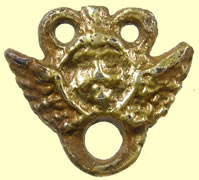 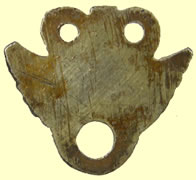 |
|
||||||||||||
Medieval gilded cherub mount - reported as treasure to Colchester museum 13.82mm H x14.84mm W, 1.05g |
1413-22 Henry V hammered silver half groat - pierced cross - mullet in centre of breast 20.59mm, 1.82g Obv HENRICxDIxGRAxREXxANGLxZFR+ Rev CIVI/TAS/LON/DON - LONDON MINT |
||||||||||||
|
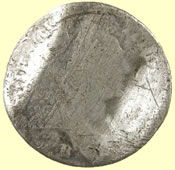 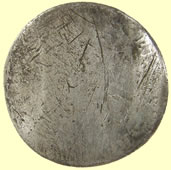 |
||||||||||||
2nd coinage 1533-1544 Henry VIII hammered silver half groat - TC beside shiled - Archbishop Thomas Cranmer) Inital mark Catherine wheel Obv HENRIC VII Rev CIVI/TAS/CAN/TOR - Canterbury mint 1.20g, 18.5mm |
1697 William III milled silver shilling - love token |
||||||||||||
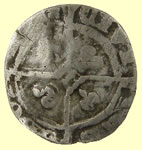 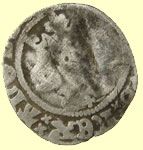 |
  |
||||||||||||
1361-69 Edward III hamered silver penny - Treaty period - York Type 2 with quatrefoil on the breast - quatrefoil with pellet at centre of reverse cross 0.73g, 15.58mm Obv *** REX ANGLI Rev CIVI/TAS/EBO/RACI - York mint
|
1613-15 James 1st hammered silver 6 pence - 2nd coinage -Cinquefoil mintmark |
||||||||||||
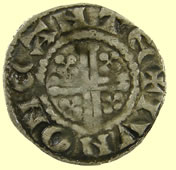 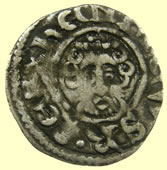 |
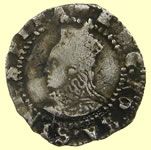 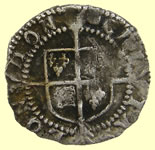 |
||||||||||||
Perfect legend on this example
1217/8 Henry III hammered silver short cross penny - Class 7a - 'A' has top and middle bar Obv HENRICVS REX Rev LVN ON CANT - Moneyer LVN of Canterbury mint |
1592-5 Elizabeth 1st hammered silver penny- Tun mintmark |
||||||||||||
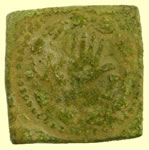 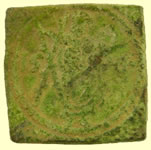 |
 |
||||||||||||
1576-9 Antwerp hand coin weight - Maker KI unknown |
Medieval decorated book clasp |
||||||||||||
  |
 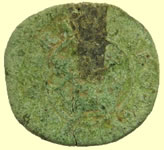 |
||||||||||||
1634 Charles 1st hammered coper Rose farthing - Type 2 |
1634 Charles 1st hammered coper Rose farthing - Type 2 |
||||||||||||
 |
 |
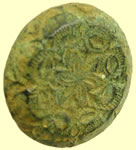 |
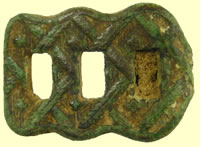 |
||||||||||
1550-1650 buckle |
18thC mount |
Georgian button |
18thC decorated clog fastener |
||||||||||
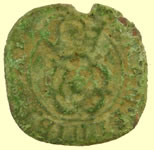 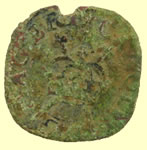 |
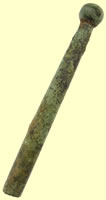 |
||||||||||||
1634 Charles 1st hammered coper Rose farthing - Type 2 |
Not sure of this yet ? |
||||||||||||
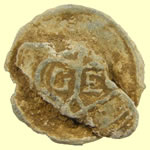 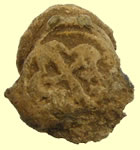 |
 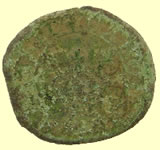 |
||||||||||||
Post medieval lead cloth seal |
1634 Charles 1st hammered coper Rose farthing - Type 2 |
||||||||||||
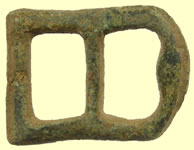 |
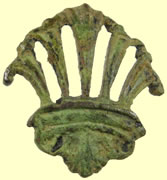 |
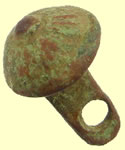 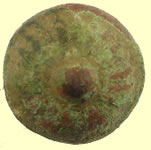 |
|||||||||||
1550-1650 buckle |
Georgian mount |
16thC Tudor button |
|||||||||||
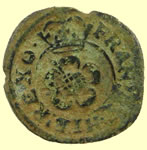 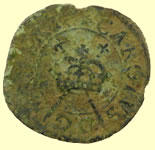 |
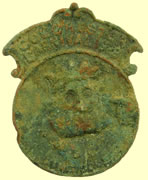 |
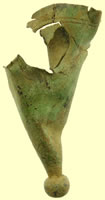 |
|||||||||||
1634 Charles 1st hammered coper Rose farthing - Type 2 |
20thC 'Old King Cole' badge |
18thC bayonet scabbard pommel |
|||||||||||
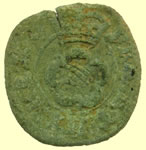  |
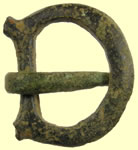 |
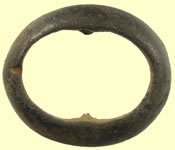 |
|||||||||||
1634 Charles 1st hammered coper Rose farthing - Type 2 |
1550-1650 buckle |
Georgian buckle |
|||||||||||
 |
 |
 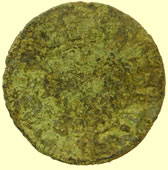 |
|||||||||||
18thC decorated clog fastener |
17thC oval mount with single integral lug |
1586 Hans Krauwincel II Rose orb Jeton HANNS KRAVWINCKEL IN NVRENB |
|||||||||||
70BC Morini 'boat tree' type Celtic gold 1/4 stater 1.48g, 10.28 mm |
|||||||||||||
Mass Bruce's Roman
NH Scott's 6 Roman's Unless I am mistaken, all 7 of these belong to the brother team of Magnentius & Decentius - a fairly short-lived (350-353 AD) Augustus/Caesar pair of the sort promoted to Augustus, ad-hoc, by their legions. This was a very common story during the chaos-years of the later 3rd century, but happened far less often in the 4th. Magnentius had been a top general of Constans' - his army proclaimed him Augustus and since Constans did him the favor of being captured and executed conveniently quickly - within a few months - Magnentius was duly recognized as Augustus in most of the Western provinces in 350. The next year he elevated his little brother Decentius to be his colleague Caesar.
Constantius II was not pleased by the Western upstarts and within 2 years had defeated them in a couple of significant battles. Realizing the jig was up, they both committed suicide in 353.
Although these reverse types are known for other rulers (for whom they are pretty rare), they are especially associated with Magnentius & Decentius, both of whom were always portrayed "bare headed" - no laurels or diadems, etc. - and both of whom sported distinctive "mullett" hairdos like you see on the clearest specimens here. Since I believe the obverse legend on that nice one of Bruce's ends in "AVG", I'd say it's most likely Magnentius. Any on which the obverse legend ends (around 5:00) in CAES, CAESAR, NOB C, or NC can safely be assumed to be Decentius.
The type with the 2 Victories resting shield inscribed: VOT / V / MVLT / X on a cippus (or just holding it between them) woul have a legend like: VICTORIAE DD NN AVG ET CAES - and was common for both of them. The large Chi-Rho Christogram reverse was used on both the centenionalis and short-lived double-centenionalis denominations - it's not really scarce, but is sought-after making it a bit more expensive for those wanting to buy one. This is a common factor in ancient coins, those with some sort of "religious" reference are always found desirable by folks who have no other interest in ancient coins, thereby driving up the prices (like the so-called "Tribute Penny" denarius of Tiberius - of which your diggers have found several - which is the most common silver coin of the early 1st century, but sells for 3-4 times as much as any other).
This pair struck only in the Western mints: Amiens, Trier, Lyon, Arles, Aquilea, Rome and Siscia
You have the Chi-Rho reverse 90º counter-clockwise out of alignment, by the way. in the left and right interstices of the Chi are "A" and "W" (Alpha/Omega). You can see these letters pretty clearly on this specimen although the "P"-shaped top of the Rho seems to have taken too much damage to be visible.
Some examples from my collection:
Magnentius: Chi-Rho double-centenionalis: http://www.stoa.org/gallery/album167/26_Magnentius_SAL_AMB
typical 2 Victories:
2 Victories from a British MD find:
a couple less-common reverses:
Decentius:
Mark
Mark Lehman has sent me futher information on Fl Don's Roman silver find
Under closer examination and tweaking the images a little, I'm pretty sure this piece at least began its career as a half-siliqua of Arcadius, 383-408 AD. If I am reading the lower letter-seriphs on the obverse correctly, what's visible should, I believe, read "D N ARCADI [ VS P F AVG]" - the legend breaking between I - V is correct for Arcadius too.
Interestingly - and I'm not sure whether this "proves" anything or not, I also have a siliqua of Arcadius showing some clipping and which also weighs exactly 0.7gm http://www.stoa.org/gallery/album83/02_Arcadius_Sil_MIL - this complicates the issue a little, since I can't see any features on the reverse of your coin which would indicate either Roma seated left (legend: VIRTVS ROMANORVM or VRBS ROMA) or a "Vota" type with vows: VOT / X / MVLT / XX in a wreath - which are the only 2 reverse types for Arcadius' siliquae - but that piece from my collection might also be a siliqua officially clipped-down to sceat-size. Certainly to make a sceat out of a half-siliqua would require the removal of a lot less metal - or your piece might merely be a skimpy, underweight half-siliqua with no clipping.
However, the reverse of yours I cannot be quite as certain about as the obverse, but I believe it is VICTORIA AVGG (or AVGGG, depending on the era - 2 emperors before, or 3 after the ascension of Theodosius II in 402) with Victory advancing left holding wreath and palm. I believe I can see [VI] CTOR [IA AVGG(G?)] between 9:00 - 11:00. The crook-like feature at the top-right should be Victory's arm holding up a wreath at about 12:00. Although these are AE denominations and some years earlier, the general design of the reverse should be the same or similar as one or the other of these two: http://www.stoa.org/gallery/album82/09_Valentinian_I_SER_ALE or http://www.stoa.org/gallery/album82/37_Valentinian_II_VIA_SIS
I can't make out anything at all for a mint mark, so I can't tell you the city of origin with certainty, but it appears that Arcadius struck half-siliquae only at Milan (MD in exergue) Aquilea (AQPS in exergue) or Rome (RM in exergue). In case you can make out letters at the bottom, that's the list of probable exergual mint marks to look for on a half-siliqua of Arcadius.
Good digging this season!
It's encouraging that your first Roman is an interesting AR instead of an AE grot for a change!
Mark |
|||||||||||||
Medieval dagger chape |
|||||||||||||
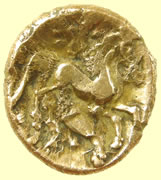  |
|||||||||||||
45 BC Addedomaros Celtic gold coin 18.64mm, 5.61g sent to CCI for recording Very unusual die strike - gold appears to be in an almost non moldern state during the strike |
|||||||||||||
 |
|||||||||||||
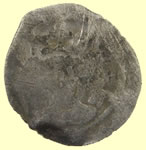
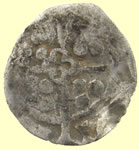
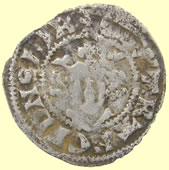

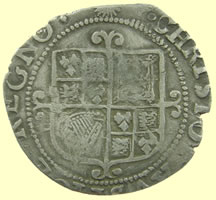
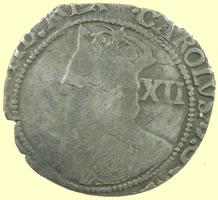

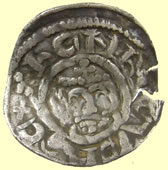
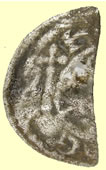


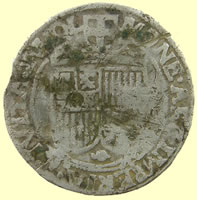

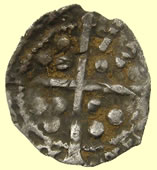

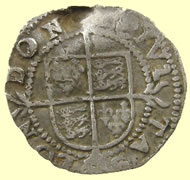

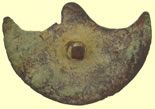
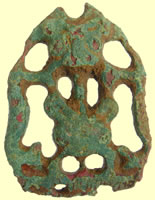
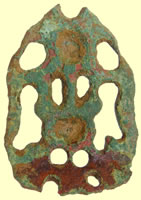
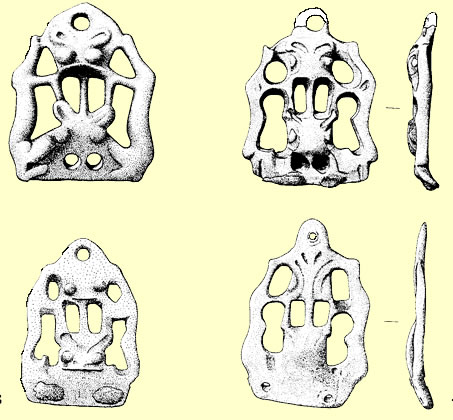
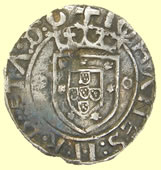
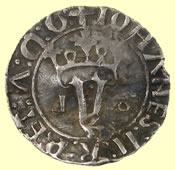
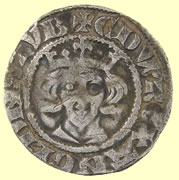
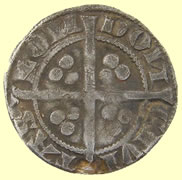
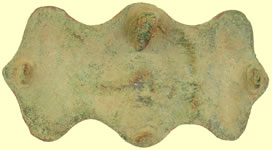
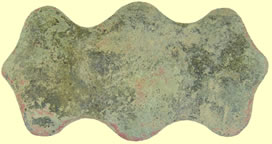



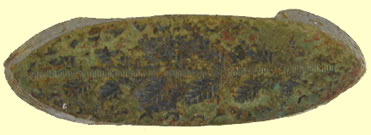
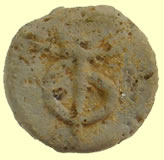
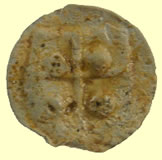


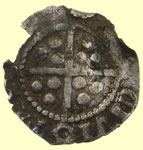

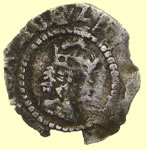
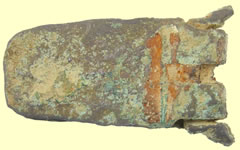
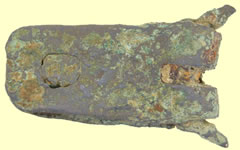


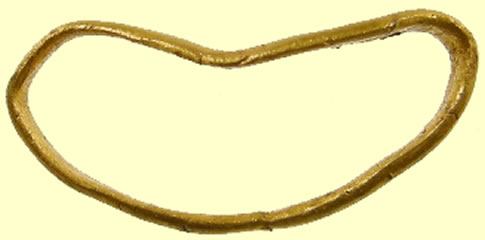



 'A badge for a Knight of the Order of the Holy Sepulchre in bronze and dating somewhere around C13/14th possibly very slightly later . This is a very scarce item and it relates to The Equestrian Order of the Holy Sepulchre of Jerusalem being a Catholic chivalric order of Knighthood that traces its roots to Godfrey of Bouillon, principal leader of the First Crusade. According to reliable sources in the Vatican and Jerusalem, it began in historical reality as a mixed clerical and lay confraternity (association) of pilgrims which gradually grew around the most central of the Christian holy places in the Middle East, the Holy Sepulchre or the tomb of Jesus Christ.This would have been a pin for a member of the order , there is a mark on the reverse where the original pin would have been fixed '
'A badge for a Knight of the Order of the Holy Sepulchre in bronze and dating somewhere around C13/14th possibly very slightly later . This is a very scarce item and it relates to The Equestrian Order of the Holy Sepulchre of Jerusalem being a Catholic chivalric order of Knighthood that traces its roots to Godfrey of Bouillon, principal leader of the First Crusade. According to reliable sources in the Vatican and Jerusalem, it began in historical reality as a mixed clerical and lay confraternity (association) of pilgrims which gradually grew around the most central of the Christian holy places in the Middle East, the Holy Sepulchre or the tomb of Jesus Christ.This would have been a pin for a member of the order , there is a mark on the reverse where the original pin would have been fixed '

